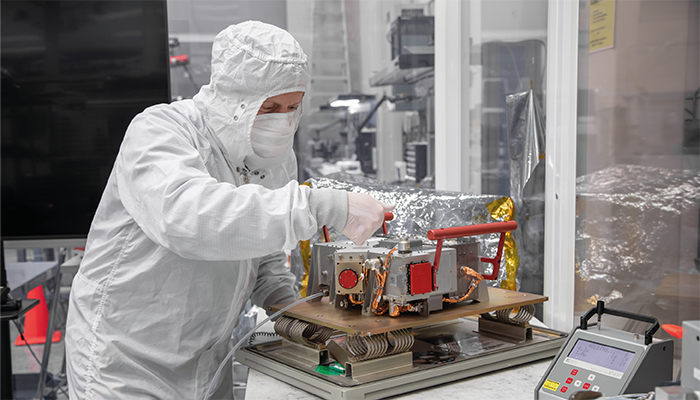
Image credit: Courtesy of SwRI
NASA's Europa Clipper launched on Monday last week atop a SpaceX Falcon Heavy rocket from NASA's Kennedy Space Center (KSC) in Florida. Their mission? To explore strange new worlds – or in this case moons, specifically Jupiter’s ocean moon Europa.
There are nine instruments aboard, including the MAss Spectrometer for Planetary EXploration (MASPEX), developed by researchers at the Southwest Research Institute (SwRI), USA.
“MASPEX has a mass resolution 50 times finer than anything that has flown to space before,” said SwRI Senior Vice President Jim Burch, who serves as MASPEX’s principal investigator in a press release. “MASPEX can differentiate between molecules with almost identical masses based on the energy binding the atoms. It also differentiates isotopes — atoms with equal numbers of protons but a different number of neutrons. These capabilities are crucial to revealing the habitability of Europa.”
The ultimate aim is to measure, using MASPEX, the molecular and isotopic composition of the plumes emanating from surface cracks on Europa to assess its potential for supporting life.
Last year, we spoke with several experts about the challenges of detecting life on moons elsewhere in the solar system – including Europa, but also Titan and Enceladus – last year, which you can read here.
Through a combination of MALDI-ToF mass spectrometry and 1D and 2D NMR, researchers discover bacterium Pseudomonas is able to alter hydroxylation and phosphorylation rates within its lipopolysaccharides to tolerate extreme Antarctic conditions. Link
MOBILion preprint: how “high resolution ion mobility” offers a means to quickly and efficiently isolate ions prior to fragmentation – eliminating the need for the quadrupole. Link
Hamid Hachemi and colleagues introduce LineageFilter – a new python-based AI software using machine-learning capabilities for refined proteotyping of complex samples using metaproteomics. Link
Preprint: researchers from the University of Washington assess the effectiveness of various entrapment methods with respect to false discovery rate (FDR) control in MS/MS analysis. Link
Ischemic preconditioning significantly enhances athletic ability, enriches metabolic pathways and reduces muscle fatigue in Taekwondo athletes, as shown by LC-MS/MS-based plasma metabolomics-based study. Link
Cryo-electron microscopy in combination with LC-MS allows imaging and analysis of protein-degrader molecules to a degree of accuracy previously deemed unattainable, presenting huge potential for treatment of neurodegenerative diseases and cancer. Link
Innovation Awards Deadline: MONDAY
Last year, Gary Siuzdak’s XCMS-METLIN took the top spot in our annual Innovation Awards. Will #TeamMassSpec retain its crown? Well, that’s up to you – and our panel of expert judges.
To ensure that we don’t miss a commercially released technology or software solution that you think is especially innovative and impactful – including from smaller spin-offs or start ups, like last year’s winner – nominate now. The deadline is today!




